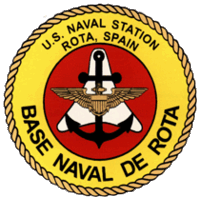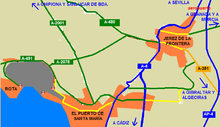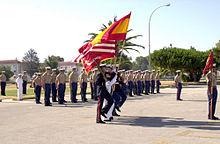- Naval Station Rota Spain
-
Naval Station Rota Rota, Spain 
US Naval Station Rota logoType Military base Coordinates 36°37′15″N 6°19′54″W / 36.620763°N 6.331558°WCoordinates: 36°37′15″N 6°19′54″W / 36.620763°N 6.331558°W Built September 26, 1953 In use 1953 – present Controlled by Spain, United States of America under several mutual aid agreements Commanders Spanish Navy Vice Admiral and the Commander, U.S. Naval Activities, Spain Naval Station Rota (NavSta Rota) (ICAO: LERT) is a Spanish naval base commanded by a Spanish Vice Admiral and fully funded by the United States of America.[1] Located in Rota, Spain, and near the Spanish town of El Puerto de Santa María, NavSta Rota is the largest American military community in Spain and houses US Navy Sailors, Marines, and their families. There are also small US Army and US Air Force contingents on the base.
Contents
Overview
Described by the US Navy as the "Gateway to the Mediterranean", Naval Station Rota is home to an airfield and a seaport; the airfield has often caused the base to be misidentified as "Naval Air Station Rota." The base is the headquarters for Commander, U.S. Naval Activities Spain (COMNAVACTSPAIN), as well as a primary gateway for Air Mobility Command flights into Europe.[2]
Naval Station Rota is strategically located near the Straits of Gibraltar and at the halfway point between the United States and Southwest Asia. Because of this ideal location, the base is able to provide invaluable support to both US Sixth Fleet units in the Mediterranean and to USAF Air Mobility Command units transiting to Germany and Southwest Asia. The Base and its tenant commands are located within the boundaries of the 6,100-acre (25 km2) Spanish 'Base Naval de Rota.' Under the guidance of the Agreement for Defense Cooperation, the US and Spanish navies work together and share many facilities. The US Navy has the responsibility for maintaining the station's infrastructure, including a 670-acre (2.7 km2) airfield, three active piers, 426 facilities and 806 family housing units.[1]
From Naval Station Rota Spain, the VLF-transmitter Guardamar, which uses Torreta de Guardamar, the tallest man-made structure in the European Union as antenna, is telecontroled.[clarification needed]
Naval Station Rota provides support for US and NATO ships; supports the safe and efficient movement of US Navy and US Air Force flights and passengers; and provides cargo, fuel, and ammunition to units in the region. The Naval Station is the only base in the Mediterranean capable of supporting Amphibious Readiness Group post-deployment wash-downs. The base port also offers secure, pier side maintenance and backload facilities. Rota supports Amphibious Readiness Group turnovers and hosts Sailors and Marines from visiting afloat units. The base also provides Quality of Life support to Morón Air Base, ARG support sites at Palma de Majorca, NATO headquarters in Madrid and the Military Sealift Command's Maritime Prepositioning Squadron 1. Rota also supports NASA Space Shuttle missions, and ongoing operations in the European theater of operations.[1]
The mission of US Forces at Rota, as well as other US Navy installations in the Mediterranean such as NAS Sigonella, Italy and Naval Air Facility Souda Bay, Crete, is to provide Command, Control and Logistics Support to US and NATO Operating Forces. These three facilities are undergoing a transformation from Maritime Patrol Aircraft airfields to Multi-role “Hubs” providing crucial air-links for USAF strategic airlift and mobility in support of US European Command (EUCOM), Central Command (CENTCOM) and African Area contingency operations under CENTCOM, EUCOM and the evolving Africa Command (AFRICOM).[1]
History
NAVSTA Rota has been in use since 1953 when Spanish dictator Francisco Franco strengthened relations with the Americans to improve local economies. The installation now covers more than 6,000 acres (24 km2) on the northern shore of Cadiz, an area recognized for its strategic, maritime importance over the centuries.
The Chief of Naval Operations deployed Submarine Squadron 16 (SUBRON 16) to Rota on 28 January 1964 and embarked upon USS Proteus (AS-19). USS Lafayette (SSBN-616) completed its first Fleet Ballistic Missile (FBM) deterrent patrol with the Polaris missile and commenced the first refit and replenishment at Rota. During the early 1970s, the submarines assigned to SUBRON 16 were completing conversion to the Poseidon missile. That transition was completed when USS Francis Scott Key (SSBN-657) returned to Rota on 14 January 1974. Treaty negotiations between Spain and the United States in 1975 resulted in a planned withdrawal of SUBRON 16 from Spain, and the Chief of Naval Operations ordered studies to select a new refit site on the East Coast of the United States. The U.S. Senate ratified the treaty in June 1976; it called for the squadron's withdrawal from Spain by July 1979. In November 1976 the Secretary of the Navy announced Naval Submarine Base Kings Bay, Georgia as that new refit site.[1]
At its peak size in the early 1980s, NAVSTA Rota was home to 16,000 sailors and their families, to include two permanently forward deployed aviation squadrons, Fleet Air Reconnaissance Squadron TWO (VQ-2) and Fleet Logistics Support Squadron TWENTY TWO (VR-22). VQ-2 was based at Rota from 1959 until 2005, when it relocated to NAS Whidbey Island, Washington. During VQ-2's tenure at Rota, it flew the P4M Mercator, EC-121 Super Constellation, EA-3 Skywarrior, and the EP-3 Aries aircraft.[3] VR-22 flew the C-130F and was based at Rota from 1982 until its inactivation in 1992. Through the early 1990s, a patrol squadron of P-3 Orion aircraft based in the United States would also be split-based between NAVSTA Rota and the Naval Air Facility at Lajes Air Base in the Azores to track Soviet naval vessels and submarines in the Atlantic Ocean and in the Mediterranean. The patrol squadrons would rotate assignment to Rota and Lajes every six months and were augmented by Naval Air Reserve patrol squadrons for shorter durations on a periodic basis.
With the downsizing of the US Navy during the late 1980s and early 1990s, especially after the end of the Cold War, the base's population dramatically declined. The US Navy maintains approximately 5,200 acres (21 km2) of the 6,000-acre (24 km2) complex. There are about 4,000 Americans in Rota, including military, civilians, and their families.[1]
The base is used jointly by Spain and the United States. It remains under the Spanish flag and is commanded by a Spanish Vice Admiral. While the Spanish Navy is responsible for external security of the base, both Navies are charged with internal security. NAVSTA Rota is technically a tenant facility of the Rota Spanish Navy base, although as such the USA enjoys the base for free and does not pay any rent to Spain. As such, certain U.S. military customs are not observed, such as the display of a U.S. Flag, which is only allowed during the annual Fourth of July celebration.
In April 2011, the commander of the US Navy garrison at the base, Captain William F. Mosk, was relieved of command and reassigned during an investigation into illegal drug use by US servicemen at the installation. Rear Admiral Tony Gaiani relieved Mosk for "lost confidence in his ability to command", specifically, to handle issues related to the investigation.[4]
On October 5, 2011, US Secretary of Defense Panetta announced that the USN will station four Aegis warships at Rota to strengthen its presence in the Mediterranean and bolster the missile defense of NATO as part of the European Phased Adaptive Approach (EPAA).
Opposition
Since the 80s, several advocacy and activist pacifist groups have marched annually to protest the presence of U.S. forces and Spanish military equipment at the port of Rota. The demonstration runs along the streets of the town to end at the gates to naval facilities at the resort, where representatives of the groups read proclamations in favor of peace and freedom.
Protests against the base cause some controversy among local residents, polarizing into two positions, in favour and against, as it provides jobs and businesses benefit from money derived from the Spanish and U.S. military. However, it seems that the U.S. presence on the base is declining[citation needed], which generates a drop in revenue from it.
Gallery
-
Police in front of the naval complex
-
Galicia class landing platform dock based at Rota.
References
- Notes
- ^ a b c d e f "NAS Rota". Globalsecurity.org. p. 7 paragraphs down. http://www.globalsecurity.org/military/facility/rota.htm.
- ^ "Commander Navy Installations Command at Rota". Rota, Spain: US Navy. 2009. http://www.cnic.navy.mil/Rota/index.htm. Retrieved 2009-10-01.
- ^ "FLEET AIR RECONNAISSANCE SQUADRON TWO". Rota, Spain: US Navy. 2009. http://vq-2.ahf.nmci.navy.mil/index.htm. Retrieved 2009-10-01.
- ^ Jontz, Sandra, "Naval Station Rota commander is relieved of command", Stars and Stripes, 19 April 2011.
External links
- U.S. Naval Station Rota, Spain website
- U.S. Naval Hospital Rota, Spain website
- Globalsecurity.org
- VQ-2 Homepage
- Video links
Categories:- Cádiz Province
- Military facilities of the United States in Spain
- Airports in Andalusia
- United States Navy bases
-
Wikimedia Foundation. 2010.







